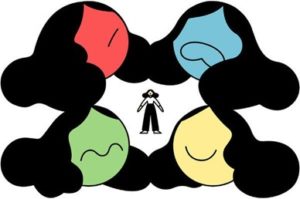Attachment Styles in Relationships
Perhaps you have never really examined how you behave in relationships. However, you may have become aware of repeating patters or cycles in your love life, even with different partners.
Perhaps you are inclined to be more involved than your partner or maybe you gravitate towards a tendency to be clingy or jealous? Or maybe you want to be in a serious relationship with someone, but as soon as emotions intensify, you feel as though you want to run for the hills?
If so, it might be beneficial for you to explore the way you attach to others…
It is our nature as humans to want contact and relationships, to want love, support, and comfort in those we connect with. It is thought that one of the key forces that drives individuals is the need to belong. However, we all know that relationships are seldom perfect and problem free as we would like them to be. We all have different ways in which we interact and behave in relationships and these styles of interaction can be categorized as ‘attachment styles.’

As children our attachment style was formed through our interactions with our primary care givers and shaped the way we perceive close relationships. For example, if a child’s physical and emotional needs are met, and he/she receives support, warmth and care during childhood, this child becomes securely attached. By recognizing our own style of attachment, we can understand the ways in which our behaviours in our close relationships may be unhealthy and see what we may need to work on to improve. Let’s have a look at the 4 attachment styles we can have and how we can recognise which style we operate from.

Secure Attachment Style
The secure attachment type thrives in close relationships, while they also have no fear of being on their own. They tend to view themselves as well as others positively, and do not require responsiveness nor the approval of their partner to feel good in themselves.
As Children
- Can separate from parent
- Goes to parent for comfort when frightened
- Expresses positive emotions when parent returns
- Prefers caregivers/parents to strangers
As Adults
- Can trust and maintain lasting relationships
- Can regulate one’s own emotions
- Are emotionally available
- Has a healthy level of self-esteem
- Has an openness to sharing feelings with partners and friends
- Tend to look for social support when needed
Anxious Attachment Style
Those of this type of attachment place great value on relationships but worry that their partner may not be as invested as they are. They are reliant on their partner for approval and support and the idea of being without their partner (or on their own) brings on anxiety. The attention or care from their partner works to sooth this anxiety and a fear of abandonment, which is strongly present with this attachment style.
As children
- Likely to be wary of strangers
- Experience much distress when parents leave
- Do not seem comforted by the return of parent
As Adults
- Reluctant to get close to others
- Intense fear of rejection
- Sensitive to criticism (real or perceived)
- Are concerned with the idea that their partner does not love them
- Clingy in relationships
- Low self esteem
- Experience great distress when relationships end
Avoidant Attachment Style
Those of this type of attachment style like to consider themselves as independent, and self-sufficient, particularly on an emotional level. There is discomfort with the idea of depending upon others or having others depend upon them. There is also a belief present that a relationship is not needed for this type to feel complete in life and a positive view of oneself present.
As Children
- May have a tendency to avoid parents
- Appear content without comfort or contact with parents
- Express little or no preference for parents over strangers
As Adults
- May experience issues with intimacy in relationships
- Are not all that emotionally invested in social and romantic connections
- Reluctant or unable to share thoughts or feelings
- Are dismissive of others
- Have difficulty trusting others
- Spend more time alone than with company
- May have commitment issues
- Feel threatened by those who attempt to get emotionally close to them
Disorganized Attachment Style
This style is typified by extremely inconsistent, confusing, and unpredictable behaviour in relationships. Those of this type of attachment style desperately want love but may push someone away as soon as they feel things are becoming emotionally intimate. There is a constant “seeking out” behaviour when it comes to love, only to reject it once it is present.
As Children
- Exhibit a mixture of avoidant and resistant behaviour
- May appear dazed, confused, or uneasy
- Some may take on the role of caregiver toward a parent
As Adults
- Fearful of rejection
- Challenging to regulate emotions
- high levels of anxiety
- Trust issues with others
- Elements of both avoidant and anxious attachment styles
Research has shown that this type of attachment style is also linked to personality disorders, mood disorders, self-harm, and substance abuse in adults.
By better understanding our attachment style we can gain insight into how this may be influencing our interactions with our nearest and dearest. Then we can work with our own awareness and willingness to improve ourselves to live more securely and more peacefully.
With this being my final blog at The DMC Clinic, I would like to say a huge thank you to those who have taken the time out for yourselves to read any or all of my blogs to date. I hope that what you read has impacted you positively in some little or large way while wishing you all health, happiness and peace of mind and heart.
Warmest wishes,
Darina

The article is written by Darina, Trainee Counsellor at The DMC Clinic. If you would like to discuss how any of the topics mentioned above are impacting your mental health, please contact The DMC Clinic to arrange an appointment.









